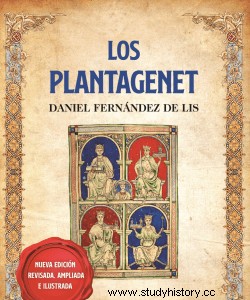
Entry taken from the book The Plantagenets
The infamous King of England, John the Landless, died in Newark-on-Trent on October 19, 1216. Upon his death, John left a divided kingdom, with an invading French army (led by the dauphin Luis, who had been called by the noble rebels against the deceased king) roaming freely through the country and the least suitable person to take charge of all the problems that came upon him when he inherited the crown:his barely nine-year-old son, Henry III. He had a complicated and uncertain reign ahead of him. Complicated it was, but not ephemeral as it might seem. In fact, he was the English king who held the throne the longest until Queen Victoria. Despite this, his name has gone almost unnoticed in history, sandwiched between two figures as charismatic (for better and for worse) as his father Juan sin Tierra and his son Eduardo I Longshanks .
If the death of a king is always an important milestone in the history of the kingdom on whose throne he sits, because of the imprint that his personality has left on it and because of the uncertainty for the future that the new monarch will bring, in the case of England and Juan sin Tierra this was reinforced by the circumstances of civil war in which the country found itself. A good part of the causes of the rebellion were due to the relationship between the king and his disaffected nobles, and after the death of Juan some of these barons considered that they had nothing against their new sovereign, who was still a child of nine years. In addition, the young king arrived under the protective shadow of a man of enormous ascendancy for all the nobility of the country, of whom we have already spoken on other occasions:William Marshal. His biography, written in a certain hagiographical tone, quotes Marshal in such a solemn moment:«If everyone leaves the boy except me, do you know what I will do? I will carry him on my shoulders and go with him from island to island and from county to county, even if I have to scavenge for my daily ration of bread.”
Henry III's coronation ceremony took place in Gloucester Abbey, since the usual place (Westminster) was in rebel hands and it was urgent to give the appearance of continuity dynasty that the kingdom required. In that austere and uncrowded place, Henry was surrounded by the aforementioned Marshal, by the justice of the kingdom Hubert de Burgh (faithful servant of the deceased king), by the Bishop of Winchester Peter des Roches and by the papal legate Bicchieri, who recalled to the whole world that England was a feudal kingdom of Rome and that it was under the protection of the Church, as Juan sin Tierra had agreed.
Despite his nearly seventy years, Marshal expended tremendous energy to free England from the yoke of the Gallic prince and the barons who had called him. On May 20, 1217, he personally led an English cavalry charge against the besieging French army along with their rebel allies. Marshal's victory was complete and the enemy fled in disarray, while the disaffected barons were captured. In the blog entry dedicated to Nicholaa de la Haye, I discussed this battle in detail.
Later, in August, Hubert de Burgh won another resounding victory against the French, this time at sea, at Sandwich, against a fleet of eighty ships sailing from Calais and it had been gathered by the prince's wife, Blanca de Castilla. Prince Louis realized that his chances of taking the English crown might be lost, and he returned humiliated to France, later acknowledging Henry as King of England in the Treaty of Kingston. William Marshal, whose father gave King Stephen hostage as a child and who had served all the Plantagenet kings (Henry II and his sons Henry the Younger, Richard I and John I), did the family one last favor by securing the throne of the grandson of the first king of the dynasty before he died in 1219.
On his deathbed, Marshal advised Henry III to place himself under the tutelage of the new papal legate, Pandulph. Henry only partially heeded the recommendation and, although he placed Pandulph as one of his closest advisers, he shared this position with the aforementioned Peter des Roches and Hubert de Burgh. On May 17, 1220, Henry's second coronation took place, this time in Westminster and with all the paraphernalia, and from then on the young king opted for De Burgh, to the point that Des Roches ended up joining the crusades .
Crown already at Westminster and seated on the throne, Henry III could devote himself to the task of ruling the country. It wasn't going to be easy for him... but that's another story.
Image| Wikimedia Commons
Fonts|
Dan Jones. Plantagenets, The Kings Who Made England .
Peter Ackroyd. A History of England Volume I (Foundations).
Roy Strong. The Story of Britain. Simon Schama. A History of Britain. Derek Wilson. The Plantagenets, The Kings That Made Britain.
Mark Morris. King John:Treachery, Tyranny and the Road to Magna Carta.
